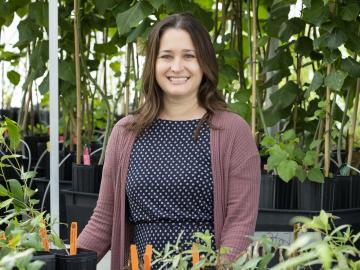
Filter News
Area of Research
- Biological Systems (1)
- Biology and Environment (42)
- Computational Biology (1)
- Computer Science (2)
- Energy Science (21)
- Fusion and Fission (4)
- Isotopes (17)
- Materials (18)
- Materials for Computing (4)
- National Security (12)
- Neutron Science (11)
- Nuclear Science and Technology (7)
- Quantum information Science (2)
- Supercomputing (51)
News Type
News Topics
- (-) Advanced Reactors (12)
- (-) Big Data (45)
- (-) Bioenergy (68)
- (-) Composites (11)
- (-) Computer Science (111)
- (-) Isotopes (33)
- (-) Mathematics (8)
- (-) Space Exploration (13)
- 3-D Printing/Advanced Manufacturing (56)
- Artificial Intelligence (77)
- Biology (80)
- Biomedical (42)
- Biotechnology (25)
- Buildings (30)
- Chemical Sciences (35)
- Clean Water (16)
- Coronavirus (19)
- Critical Materials (5)
- Cybersecurity (14)
- Education (2)
- Emergency (3)
- Energy Storage (32)
- Environment (116)
- Exascale Computing (51)
- Fossil Energy (6)
- Frontier (44)
- Fusion (38)
- Grid (32)
- High-Performance Computing (81)
- Hydropower (6)
- ITER (4)
- Machine Learning (37)
- Materials (51)
- Materials Science (55)
- Mercury (7)
- Microelectronics (3)
- Microscopy (23)
- Molten Salt (2)
- Nanotechnology (17)
- National Security (60)
- Neutron Science (82)
- Nuclear Energy (66)
- Partnerships (36)
- Physics (34)
- Polymers (9)
- Quantum Computing (35)
- Quantum Science (48)
- Security (16)
- Simulation (42)
- Software (1)
- Statistics (2)
- Summit (40)
- Transportation (30)
Media Contacts

To optimize biomaterials for reliable, cost-effective paper production, building construction, and biofuel development, researchers often study the structure of plant cells using techniques such as freezing plant samples or placing them in a vacuum.

Two decades in the making, a new flagship facility for nuclear physics opened on May 2, and scientists from the Department of Energy’s Oak Ridge National Laboratory have a hand in 10 of its first 34 experiments.

Scientists develop environmental justice lens to identify neighborhoods vulnerable to climate change
A new capability to identify urban neighborhoods, down to the block and building level, that are most vulnerable to climate change could help ensure that mitigation and resilience programs reach the people who need them the most.

It’s a simple premise: To truly improve the health, safety, and security of human beings, you must first understand where those individuals are.

What’s getting Jim Szybist fired up these days? It’s the opportunity to apply his years of alternative fuel combustion and thermodynamics research to the challenge of cleaning up the hard-to-decarbonize, heavy-duty mobility sector — from airplanes to locomotives to ships and massive farm combines.

A team of researchers has developed a novel, machine learning–based technique to explore and identify relationships among medical concepts using electronic health record data across multiple healthcare providers.

Tackling the climate crisis and achieving an equitable clean energy future are among the biggest challenges of our time.

ORNL scientists had a problem mapping the genomes of bacteria to better understand the origins of their physical traits and improve their function for bioenergy production.

The rapid pace of global climate change has added urgency to developing technologies that reduce the carbon footprint of transportation technologies, especially in sectors that are difficult to electrify.

The Center for Bioenergy Innovation at ORNL offers a unique opportunity for early career scientists to conduct groundbreaking research while learning what it takes to manage a large collaborative science center.


